Apple's 2010 MacBook Air (11 & 13 inch) Thoroughly Reviewed
by Anand Lal Shimpi on October 26, 2010 10:08 PM EST- Posted in
- Mac
- Apple
- MacBook Air
- Laptops
Performance
Benchmarking under OS X isn’t difficult, you just need to get creative. Luckily I’m in dire need of creative outlets so creating OS X benchmarks works for me. I’m using the same tests I introduced in my Holiday 2009 Macbook Pro roundup and running on the launch hardware for each notebook listed in the charts.
We’ll start with general application performance.
General OS usage is a difficult thing to quantify, but one measure of performance has always been the number of bounces an icon in the dock makes before an application loads. I decided to take it to the next level and write a quick script to launch 15 applications in a row, timing how long the entire process takes.
I launched, in order: Mail, Safari, Activity Monitor, iTunes, iCal, DVD Player, iPhoto, Photo Booth, Quicktime Player, Disk Utility, Preview, iMovie, Front Row, Garage Band and Aperture.
The entire process stresses both the disk and CPU, which is why we see a huge improvement when going to an SSD as well as differences between CPU speeds.
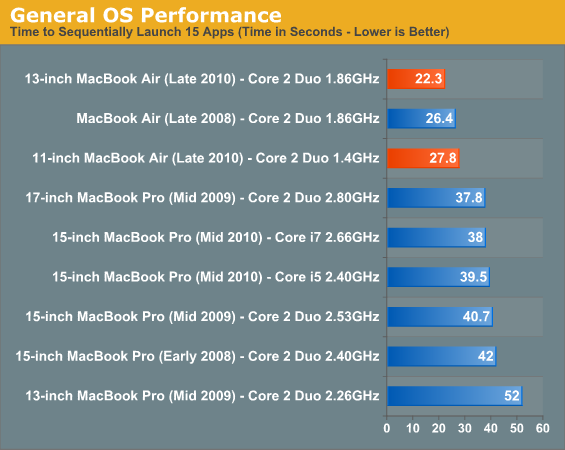
What a difference an SSD can make. The 13-inch MacBook Air is the fastest standard shipping configuration Apple offers in this benchmark. The fact that there's a measurable difference between the 13-inch and 11-inch models shows you just how slow that 1.4GHz Core 2 really is.
Adobe Photoshop CS4 Performance
The Retouch Artists Speed Test we use for our CPU testing under Windows also works under OS X. We're running the exact same benchmark here, basically performing a bunch of image manipulations and filters and timing the entire process.
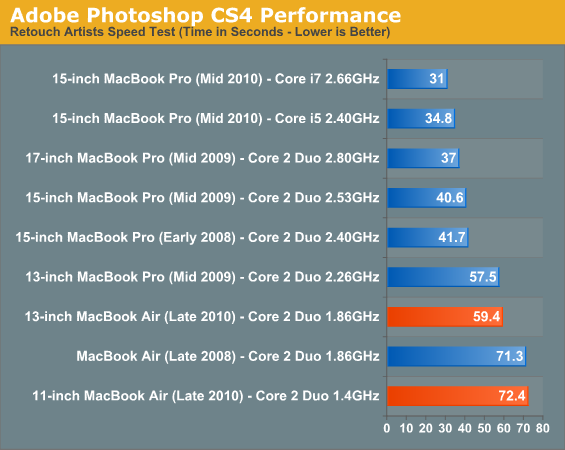
The 13-inch MacBook Air performs as well as last year's 13-inch MacBook Pro. But if you plan on doing real work, you'll be hampered by the performance of these systems. Apple really needs to find a way to get an Arrandale or Sandy Bridge into this chassis
Aperture 2 RAW Import
For my Aperture test I simply timed how long it took to import 203 12MP RAW images into the library.
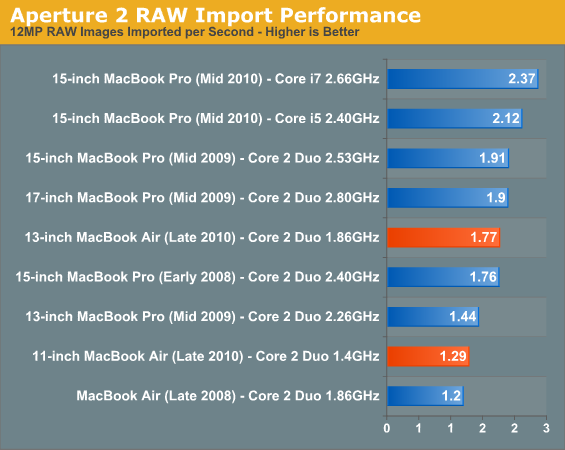
The SSD makes the 13-inch MacBook Air far more competitive than it should be here. It's even faster than a two year old 15-inch MacBook Pro. The 11-inch MBA is faster than the old 13-inch MBA due to its better thermal characteristics as we pointed out earlier.
Cinebench R10
I’m a fan of the Cinebench test because it lets me show off both single and multithreaded performance in the same workload. First, the single threaded performance:
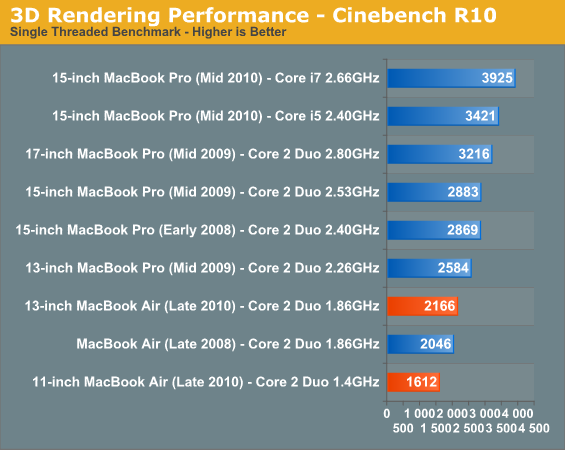
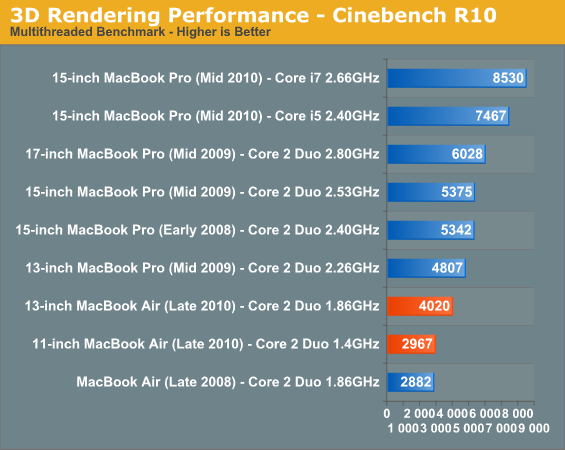
The performance in both of these tests in line with the rest of the results. These notebooks aren't very good at intensive workloads. It is worth pointing out that the 13-inch MacBook Air posts better numbers here than the old dual processor 2.5GHz PowerMac G5 :)
Quicktime H.264 Video Encoding
Our final benchmark is more consumer focused. Here I'm taking an XviD and converting it to an iPhone-supported H.264 format.











185 Comments
View All Comments
cabjf - Tuesday, October 26, 2010 - link
The fact that the iPad will easily sync with your main computer does give it one advantage over the Air. If Apple produced some type of easy to use syncing software so that you could use the Air as a portable version of your main computer's contents, it would be the perfect road companion to an iMac, Mac Pro, or even a 17-inch Macbook Pro. Perhaps that is the way they are moving in bringing an App Store and other iOS features to Mac OS X. Maybe that's part of the intended use for that huge data center they are building (and already considering expanding).wintermute000 - Wednesday, October 27, 2010 - link
" If Apple produced some type of easy to use syncing software so that you could use the Air as a portable version of your main computer's contents, it would be the perfect road companion to an iMac, Mac Pro, or even a 17-inch Macbook Pro."Easily done with a bit of work
- know where the files are and don't do things like let itunes sort folders
- rsync or any decent gui backup/sync software
storage is an issue but for work purposes 64Gb is enough to handle it
for streaming media use streaming media solutions.
psonice - Wednesday, October 27, 2010 - link
Apple sell 'mobile me' which pretty much does this. It gives you an 'iDisk' in the cloud, accessible from any of your machines (think it supports windows too?), plus there's an iphone app to access it. It also syncs your bookmarks, preferences, dock icons (don't think it syncs the actual apps though) and keychain (for passwords). There's push email + web hosting (main thing I use it for) and other bits too.It's $60/year, and it's possible to get pretty much everything for free elsewhere. But like a log of apple stuff, it works well, it's nicely integrated, and if you have the money it's not worth arsing around with the others.
Tmoz - Wednesday, October 27, 2010 - link
You could use Dropbox to do this: http://db.tt/eiXQTsi (Disclosure: Referral link)It syncs your files to Amazon S3 and then to any computers you have the software installed on (Mac/Windows/Linux are supported)
dendysutrisna - Friday, August 12, 2011 - link
Yes I understand, since this article was made when Apple's MacBook Air which has been reinforced Intel Core i5 has not come out. MacBook Air the latest generation, which has been paired with Mac OS X Lion, there is a AirDrop feature, where you can share with computer around you which in one network, even with the computer windows though. Try to look http://www.bestdealscomputers.net/netbooks/apple-m... I've made a little review about the newest MacBook Air, you might want to find out more.quiksilvr - Tuesday, October 26, 2010 - link
Seriously, their pricing scheme makes absolutely no sense. I have attempted to see what COULD be the decent price point, but a few points have to be made:1) The Macbook 13 (the white one) simply needs to die.
2) They are now hitting 4 different screen sizes, and IMO they should stick to three and make things easier (as should other PC makers)
1) 12" screen (not 11.6", 12") for the netbook market
2) 14" screen for the general market
3) 16" screen for the heavy multimedia and desktop replacement market
3) Get rid of the "Pro" terminology. Simply have it Macbook 12, 14, 16 and Air versions of these models (Macbook Air 12, etc.)
4) STOP forcing customers to get the "upgraded" version just so that we can upgrade the CPU. This is annoying and very Dell like and customers don't like it.
martyrant - Tuesday, October 26, 2010 - link
Apple has needed a price overhaul since the company's inception.Glad you are only now realizing.
darwinosx - Tuesday, November 2, 2010 - link
You are just too dumb to understand that similar quality, service, and a modern OS from other companies is as much or more than Apple products. Except they don't have a modern OS.quiksilvr - Tuesday, October 26, 2010 - link
Okay, here is my attempt (and I know this will never happen because it makes too much sense)Macbook Air 12: $799
Macbook 12: $599
Macbook Air 14: $999
Macbook 14: $799
Macbook Air 16: $1199
Macbook 16: $999
And as shocking as this may seem to Mac users, this is still a major premium over PCs.
Macbook Air Baseline:
-Core i3 LV (or ULV) with Core i5/i7 LV/ULV option (add thickness if necessary)
-Integrated Intel HD chip and dedicated nVidia card with Optimus
-SSD (I would say start it at 90GB and work your way up)
-USB 3.0 all the way
-mini Displayport with choice of adaptor included (DVI, VGA, HDMI, Displayport, etc.)
-Wireless, Bluetooth, yada yada
-4 GB RAM
-No Optical
-And one thing I just noticed, put an actual microphone PORT and put a stereo microphone next to the webcam
-Expresscard Slot option
Macbook Baseline:
-Core i3 with Core i5/i7 option (add thickness if necessary)
-Integrated Intel HD chip and dedicated nVidia card with Optimus
-HDD with SSD option (start HDD with 250GB)
-USB 3.0
-mini Displayport with choice of adaptor included (DVI, VGA, HDMI, Displayport, etc.)
-Wireless, Bluetooth, yada yada
-4 GB RAM
-DVD Burner with Blu Ray Player/Blu Ray Burner option
-Expresscard Slot option
5) And for the love of god, stop making these screens epic glossy. This is a message to ALL PC makers! Make it half and half or give a realistically priced matte option (FREE)
solipsism - Tuesday, October 26, 2010 - link
Nothing you wrote makes sense.How much is the ULV CPU from Intel?
How much is the LV CPu from Intel?
How much is that Nvidia 320M?
How much does it cost to mill an aluminum case?
How much are 9.5mm ultra-slim slot-loading BRDs?
Can you find any for sale?
Which Core-i3 LV and ULV chips will they use?
Which USB3.0 controller will they use, how much will cost, where will go in the Airs?
Where will this ExpressCard slot go?
Why scrape the 11, 13 and 15” Mac notebooks for 12, 14 and 16” displays?
Why didn’t you fail to address the size, weight, or quality of anything? You just took a price that you compared to other vendors, bumped it slightly and then added a whole mess of features without considering engineering, costs, or anything else. You might as well add include TARDIS technology to fit all that in there and/or use a TARDIS to go into the future to a time when all that is actually possible, but instead you just sound like a TARD in your self proclaimed “makes too much sense” post.